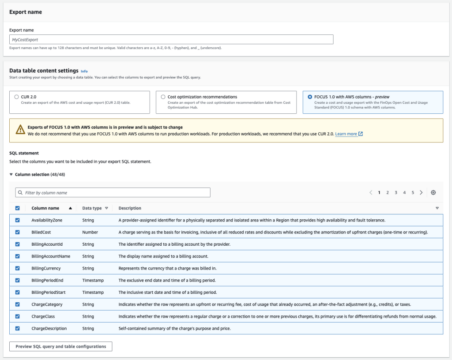What Is FinOps Open Cost and Usage Specification (FOCUS)?
FOCUS (FinOps Open Cost and Usage Specification) provides a standardized approach for managing financial governance related to cloud operations. It ensures that complex financial data from different cloud services are consolidated into a simplified and uniform format. This specification helps organizations navigate diverse billing systems and cost structures found across different cloud providers.
FOCUS gives organizations an authoritative framework for decoding cloud expenditures, leading to more informed decision-making. It aligns multiple data points into a coherent dataset, promoting a clear understanding of expenses across departments.
Learn more in our blog post: Focus 1.0 and Anodot
What Problem Does FOCUS Solve?
FinOps practitioners often face the time-consuming task of collecting and normalizing cloud billing data from various vendors, each using unique terminology and metrics. This inconsistency delays the analysis process, forcing practitioners to spend valuable time on data transformation instead of delivering actionable insights.
FOCUS solves this problem by standardizing cost and usage data into a unified format, allowing practitioners to focus on strategic tasks like optimizing cloud spend and forecasting budgets.
Integrating new vendors into an organization’s cloud ecosystem can be a significant challenge due to differing data schemas. FOCUS mitigates this by providing a predefined structure for onboarding new vendors, eliminating the need for custom data transformations. This enables smoother integration and quicker access to valuable financial insights.
The FOCUS Specification
The FOCUS 1.0 specification defines a consistent format for billing data, including 43 standardized columns covering cost metrics and categorization dimensions. These columns ensure that billing files are comprehensive and uniform, making them easier to analyze across vendors. Key columns like “BilledCost” and “AvailabilityZone” clarify essential billing details, enabling accurate cost allocation and reporting.
FOCUS also includes built-in support for extract-transform-load (ETL) processes, helping organizations simplify data ingestion and validation. This design ensures that billing files conform to the specification, minimizing discrepancies and improving data quality. Practitioners can rely on consistent datasets for tasks such as multi-cloud cost optimization, vendor comparisons, and resource rightsizing.

- Integrate FOCUS into existing FinOps workflows: Embed FOCUS datasets into established budgeting, forecasting, and reporting workflows. This enhances the accuracy and consistency of financial insights while minimizing disruptions during adoption.
- Map FOCUS data to business KPIs: Translate FOCUS outputs into business-relevant metrics, such as cost per user, cost per transaction, or profitability by product line. This helps stakeholders connect cloud costs to broader organizational objectives.
- Use FOCUS for resource rightsizing: Leverage the granular cost insights in FOCUS exports to identify over-provisioned or underutilized resources. Regularly optimize these resources to align usage with actual demand.
- Automate reconciliation processes: Automate the reconciliation of FOCUS data with vendor invoices and internal chargeback/showback systems. This reduces manual errors and ensures financial alignment across systems.
- Combine FOCUS with AI-driven analytics: Enhance FOCUS datasets with AI-powered tools to detect patterns, forecast future costs, and identify anomalies. This allows for more proactive and predictive financial management.
Benefits of Implementing FOCUS
Here are the key benefits FOCUS can provide organizations using the cloud:
- Improved data consistency across vendors: FOCUS enables consistent reporting across multiple cloud providers, eliminating the need to analyze each vendor separately.
- Simplified billing data management: By standardizing billing data into a single, consistent format, FOCUS reduces the complexity of managing diverse billing files. Practitioners no longer need to learn unique terminologies for each cloud provider.
- Simplified integration of new vendors: When onboarding new cloud providers, organizations using FOCUS benefit from a predefined data transformation format. This accelerates the integration process and eliminates the need to develop custom solutions for each new vendor.
- Enhanced reporting accuracy: A uniform structure for billing data reduces discrepancies in terminology and definitions, leading to more accurate and reliable reporting.
- Increased portability and flexibility: With FOCUS, practitioners can apply their skills across multiple cloud environments, FinOps tools, and organizations. Its standardized approach enables seamless transitions when tools or vendors change.
- Cost efficiency in data processing: FOCUS combines billed and amortized costs into a single dataset, reducing the computational and storage resources needed for data processing.
Who Can Use FOCUS
The specification is useful for both professionals and vendors.
FinOps Practitioners
FinOps practitioners are primary users of FOCUS, which is used to simplify processes around cloud financial management. FOCUS supports these professionals by providing a clear framework for aligning financial goals with cloud usage. This alignment translates complex billing data into unified and understandable reports, aiding efficient budget forecasting and cost-management strategies.
FinOps practitioners benefit from operational efficiencies offered by FOCUS. It provides tools to improve collaboration between finance, engineering, and operations teams, using standardized datasets to enable transparent communication.
Cloud Vendors
Cloud vendors use FOCUS to offer their customers more transparent and consistent billing solutions. By adopting FOCUS into their reporting structures, vendors can improve the accuracy and reliability of the financial information customers receive.
Implementing FOCUS also allows cloud vendors to improve customer satisfaction by providing clear insights and understandings of cost structures. Additionally, vendors benefit from simplified processing and reduced complexity in their billing systems.
FinOps Tool Vendors
FinOps tool vendors can leverage FOCUS to improve their analytical capabilities and reporting tools. By integrating FOCUS specifications, these vendors can offer more precise and standardized solutions that align with industry requirements. This enables tool vendors to provide their customers with comprehensive financial insights and analyses and better support cross-cloud cost management.
Managed Service Providers
Managed service providers (MSPs) can leverage FOCUS to streamline their clients’ financial operations. By standardizing cost and usage data across multiple cloud platforms, MSPs can provide clearer cost insights, optimize cloud spend, and enhance billing transparency.
FOCUS allows MSPs to deliver more consistent financial reporting, making it easier for customers to understand their cloud expenses and optimize their infrastructure accordingly. Additionally, MSPs can integrate FOCUS with existing FinOps tools to automate cost monitoring and anomaly detection, improving the efficiency of cloud financial management services.
Example: FOCUS on AWS
AWS has introduced the ability to export cost and usage data by the FinOps Open Cost and Usage Specification (FOCUS) 1.0 schema as a preview feature.
AWS customers can configure recurring exports of their cost and usage data using the FOCUS 1.0 schema, delivered to an Amazon S3 bucket. The summed billed costs in these exports align directly with AWS invoices, ensuring consistency and reliability.
How FOCUS exports work in AWS:
- Standardized cost columns: Data exports include consistent columns such as ListCost, BilledCost, and EffectiveCost, providing clear definitions for each type of cost. This ensures easy validation and reconciliation of discounts.
- Unified schema: The FOCUS 1.0 schema applies consistent formatting across all columns. AWS-specific data, such as usage types and cost categories, is also included using dedicated fields with an x_ prefix.
- Common value set: FOCUS ensures uniform terminology across datasets. For example, usage measured in hours is labeled consistently as “Hours,” avoiding ambiguities like “hr” or “hrs.”
How to activate focus in AWS:
Users can activate FOCUS exports through the AWS Billing and Cost Management console. Options include setting export frequencies and specifying storage destinations. Access permissions can be controlled via AWS IAM policies.
Best Practices for Using FOCUS
Here are a few ways you can make better use of FOCUS in your organization.
1. Keep Data Up-to-Date
Maintaining current and accurate datasets is critical when using FOCUS. Organizations should establish regular data refresh processes to ensure financial data reflects real-time operations. This practice helps maintain data accuracy and reliability.
Accurate and up-to-date data also supports compliance with financial reporting standards, reducing the risk of discrepancies and errors.
2. Use FOCUS for Cross-Cloud Analysis
FOCUS enables easier cross-cloud analysis by standardizing financial datasets across different service providers. This capability is crucial for organizations that utilize multi-cloud environments, providing them with a coherent framework for analyzing costs and optimizing usage.
Employing FOCUS for cross-cloud analysis also simplifies the decision-making process. It allows stakeholders to evaluate the performance and costs of their cloud services based on a standardized dataset.
3. Leverage Community Resources
The FinOps community is a valuable resource for organizations using FOCUS. Engaging with community forums, attending events, and participating in discussions can provide insights into best practices and new developments in cloud financial management.
Here are three key resources provided by the FinOps Foundation that can help organizations maximize their use of FOCUS:
- FinOps Foundation Slack Community: The FinOps Foundation hosts an active Slack workspace where FinOps practitioners, vendors, and experts share insights, solve problems, and discuss industry trends. This resource offers real-time support and discussions on implementing FOCUS and broader FinOps practices.
- Working Groups and Special Interest Groups (SIGs): The Foundation organizes working groups that focus on specific topics like cost allocation, tooling, or cloud vendor-specific best practices. These groups help refine best practices and update the FOCUS specification to meet emerging challenges in cloud financial management.
- FinOps Certified Practitioner Program: This certification program equips FinOps practitioners with the knowledge needed to implement standards like FOCUS. It covers practical applications, cross-cloud analysis, and data management, helping practitioners advance their expertise in cloud cost optimization.
4. Contribute to the FOCUS Specification
Contributing to the FOCUS specification strengthens the community and improves the tool’s development. Organizations that actively participate in refining and evolving FOCUS drive innovation and ensure the specification continues to meet industry needs.
Contributions can involve providing feedback, suggesting improvements, or developing new use cases. By participating in the development of FOCUS, organizations also gain early insights into upcoming changes and improvements.
Umbrella’s the All-in-One FinOps Solution
Umbrella’s is an AI-based cost management platform that helps businesses understand cloud unit economics by aligning cloud costs to key business dimensions. This allows users to track and report on unit costs, providing a clear picture of how infrastructures and economies are evolving.
As a third-party tool, we aim to contribute to the success of FOCUS by continuing to provide our users with comprehensive documentation, hands-on support, and dedicated customer success teams, thereby maximizing FinOps FOCUS benefits and helping them achieve their cloud cost management goals.
FOCUS 1.0 is the future, and as a leading platform for Cloud Cost Management, we’re here to support FinOps in its new era of innovation.
Read more about FOCUS and Umbrella here.

